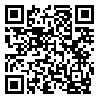Volume 76, Issue 1 (April 2018)
Tehran Univ Med J 2018, 76(1): 19-25 |
Back to browse issues page
Download citation:
BibTeX | RIS | EndNote | Medlars | ProCite | Reference Manager | RefWorks
Send citation to:



BibTeX | RIS | EndNote | Medlars | ProCite | Reference Manager | RefWorks
Send citation to:
Seyfi S, Banihashem N, Hassannasab B, Amri P. Comparison of surgical and percutaneous tracheostomy method in the intensive care unit. Tehran Univ Med J 2018; 76 (1) :19-25
URL: http://tumj.tums.ac.ir/article-1-8665-en.html
URL: http://tumj.tums.ac.ir/article-1-8665-en.html
1- Clinical Research Development Unit, Rouhani Hospital, Babol University of Medical Sciences, Babol, Iran. Department of Anesthesiology, School of Medicine, Babol University of Medical Sciences, Babol, Iran.
2- Clinical Research Development Unit, Rouhani Hospital, Babol University of Medical Sciences, Babol, Iran. Department of Anesthesiology, School of Medicine, Babol University of Medical Sciences, Babol, Iran. ,pamrimaleh@gmail.com
2- Clinical Research Development Unit, Rouhani Hospital, Babol University of Medical Sciences, Babol, Iran. Department of Anesthesiology, School of Medicine, Babol University of Medical Sciences, Babol, Iran. ,
Abstract: (4394 Views)
Background: Prolonged mechanical ventilation and the need for tracheal intubation are the main indication of tracheostomy. This procedure can be done, in two ways: surgical tracheostomy or percutaneous tracheostomy. In this study, surgical tracheostomy was compared with percutaneous method in the intensive care unit.
Methods: This clinical trial study was performed on 61 patients admitted to the intensive care unit of Ayatollah Rohani Hospital of Babol University of Medical Sciences from April 14, 2013 to April 14, 2016. In the first group (44 cases), tracheostomy was performed in percutaneous (PDT) and in the second group (17 patients) surgically. The early complications and waiting time (intubation to tracheostomy) for tracheostomy were compared in two groups. All data were analyzed by SPSS software, ver. 22 (Armonk, NY, USA), Analysis of variance (ANOVA) and P values of less than 0.05 were considered significant.
Results: The mean age of the patients was 59.87±8.15 years. The mean age of the male patients was 59.66±6.35 years and the female patients were 60.35±6.41 years. In this study, the average waiting time (time from intubation to tracheostomy) was 14.19 days in the PDT group and 20.69 days in the tracheostomy group, with a significant difference between the two groups (P= 0.001). The incidence of preoperative bleeding after surgery was five cases (8.2%). In the PDT group, two cases (3/3%) and the surgical group was three cases (4.9%) and the two groups did not have a significant difference (P= 0.46). The incidence of wound infection (during the period of admission and up to ten days later) in two groups was two patients (3.3%), one case (1.6%) In the PDT group, and one case (1.6%) in a surgical group and the two groups did not have a significant difference (P= 0.43). Other complications such a subcutaneous emphysema and posterior tracheal wall trauma and rupture was not shown in both groups.
Conclusion: The findings of this study showed that the complications (bleeding and wound infections) did not differ between the two groups. Due to the lower waiting time and the lack of need for patient transfer outside of the intensive care unit, percutaneous tracheostomy can be a safe alternative to the surgical tracheostomy.
Methods: This clinical trial study was performed on 61 patients admitted to the intensive care unit of Ayatollah Rohani Hospital of Babol University of Medical Sciences from April 14, 2013 to April 14, 2016. In the first group (44 cases), tracheostomy was performed in percutaneous (PDT) and in the second group (17 patients) surgically. The early complications and waiting time (intubation to tracheostomy) for tracheostomy were compared in two groups. All data were analyzed by SPSS software, ver. 22 (Armonk, NY, USA), Analysis of variance (ANOVA) and P values of less than 0.05 were considered significant.
Results: The mean age of the patients was 59.87±8.15 years. The mean age of the male patients was 59.66±6.35 years and the female patients were 60.35±6.41 years. In this study, the average waiting time (time from intubation to tracheostomy) was 14.19 days in the PDT group and 20.69 days in the tracheostomy group, with a significant difference between the two groups (P= 0.001). The incidence of preoperative bleeding after surgery was five cases (8.2%). In the PDT group, two cases (3/3%) and the surgical group was three cases (4.9%) and the two groups did not have a significant difference (P= 0.46). The incidence of wound infection (during the period of admission and up to ten days later) in two groups was two patients (3.3%), one case (1.6%) In the PDT group, and one case (1.6%) in a surgical group and the two groups did not have a significant difference (P= 0.43). Other complications such a subcutaneous emphysema and posterior tracheal wall trauma and rupture was not shown in both groups.
Conclusion: The findings of this study showed that the complications (bleeding and wound infections) did not differ between the two groups. Due to the lower waiting time and the lack of need for patient transfer outside of the intensive care unit, percutaneous tracheostomy can be a safe alternative to the surgical tracheostomy.
Type of Study: Original Article |
Send email to the article author
| Rights and permissions | |
 |
This work is licensed under a Creative Commons Attribution-NonCommercial 4.0 International License. |





